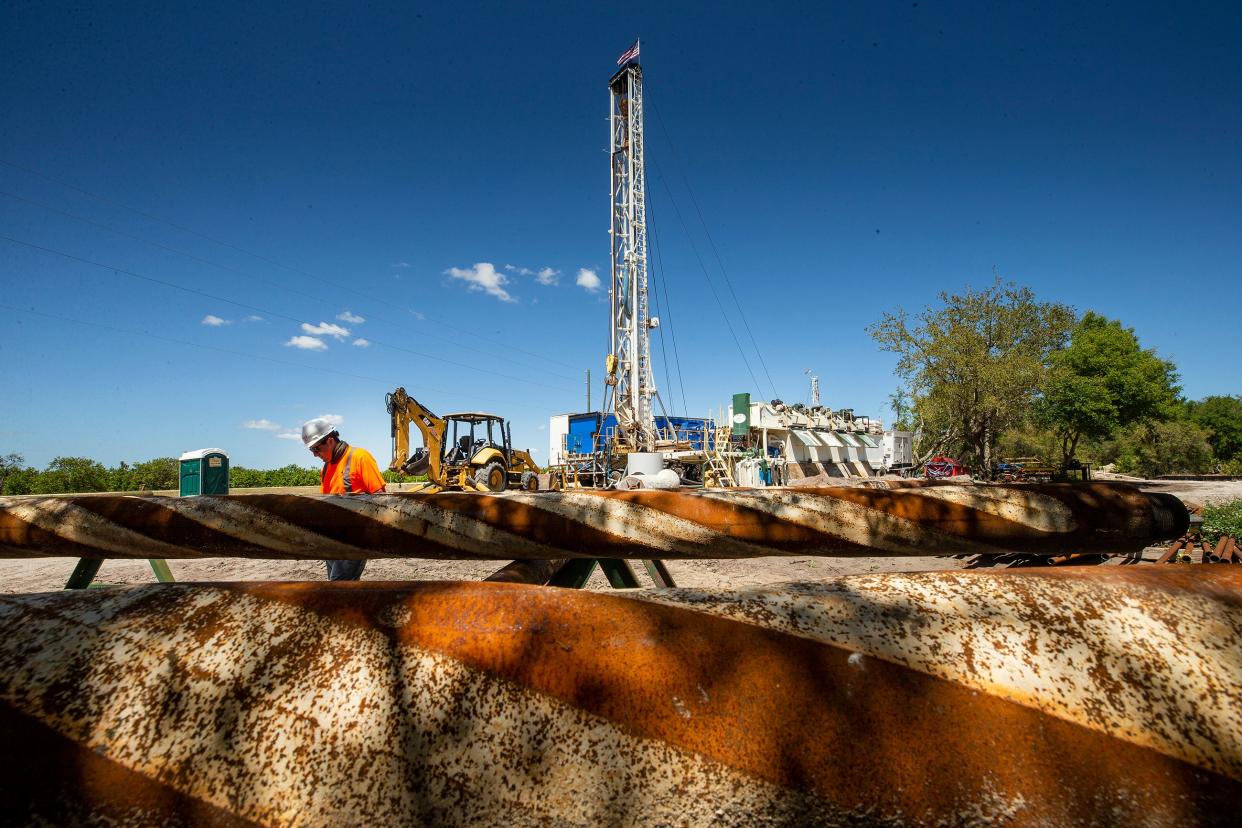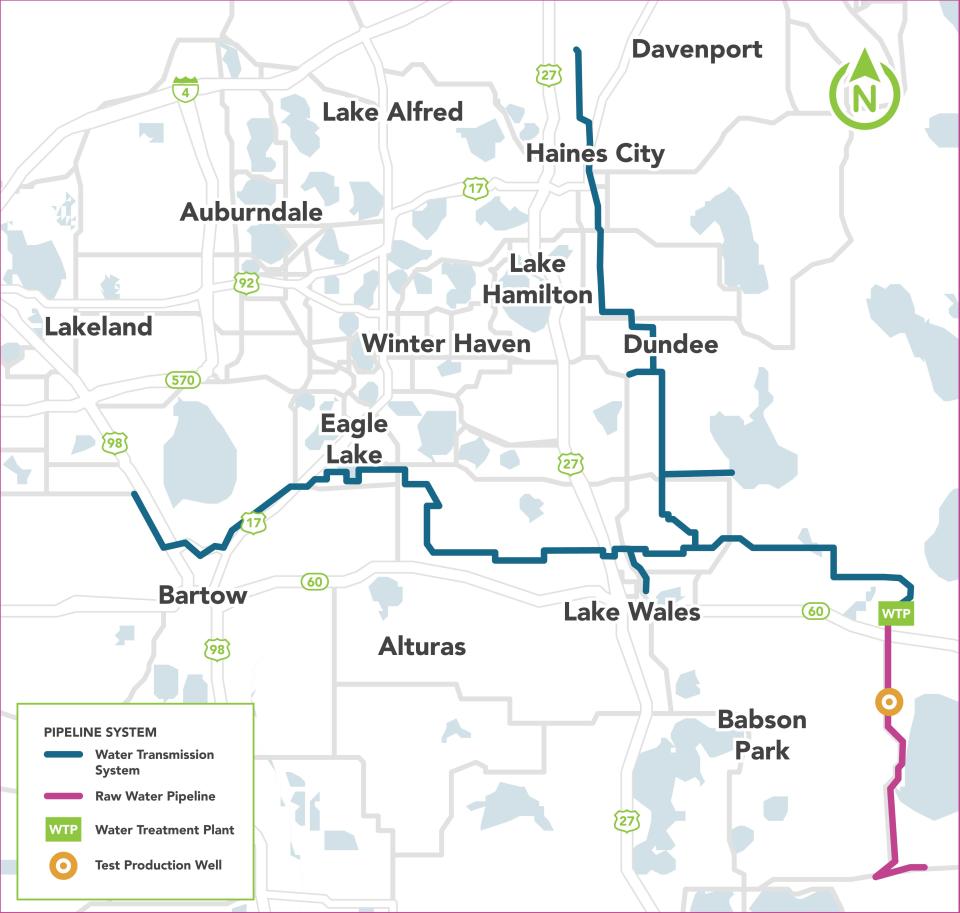Lake Wales might seek water from Polk Cooperative as plans for its own well seem shaky

It appears that Lake Wales will not be going it entirely alone on future water supplies after all.
Sara Irvine, the city’s special projects administrator, told city commissioners at a recent workshop that plans to drill a city-owned deep well are now in serious doubt. That means Lake Wales is likely to seek water from the Southeast Wellfield and Water Production Facility, a project being developed by the Polk Regional Water Cooperative.
Irvine reported that the Southwest Florida Water Management District had drilled an exploratory well in the same general area west of Lake Wales that the city had selected as the site for a well into the Lower Floridan Aquifer. The district determined that the aquifer in that area would not support a productive well.
As Irvine told commissioners, Lake Wales' best option now is to request water from the Southeast Wellfield project. That would assume financial obligations of nearly $1 million to the Polk Regional Water Cooperative.
“So, it just looks like the only practical thing for us to do at this point is go regional,” City Commissioner Robin Gibson said in response to Irvine’s report at the March 27 work session.
“It looks like it,” Irvine replied.
“Well, it was certainly worth a look,” Gibson replied.
Lake Wales did not actually begin drilling a test well, and the city's only expenditure was what Irvine called a "minimal" amount paid to a consultant to prepare the plans.
The Polk Regional Water Cooperative
Lake Wales is one of only four cities that so far have not committed to receiving water from one of two deep well projects that the PRWC is developing.
The cooperative formed in 2017 in recognition that Polk County and its cities were approaching the limit of increased volumes of water they could withdraw from conventional wells drilled into the Upper Floridan Aquifer, an underground reservoir that provides most of the state’s water supply.
The PRWC comprises Polk County and 15 cities. While each entity contributes administrative fees, the cooperative operates as a subscription service, with the county and cities paying additional money based on their receipt of water.
Lake Wales is now considered an associate with the Southeast Wellfield project and has the option to become a participating member, said Eric DeHaven, the PRWC’s executive director.
The Southeast Wellfield project encompasses a series of wells being drilled north of Frostproof, along with a water treatment facility and a 61-mile pipeline. The wells, the first of which began construction in late 2022, will extend as deep as 2,000 feet underground, compared with depths of 700 to 800 feet for conventional wells into the upper aquifer.

Water in the Lower Floridan Aquifer is briny, rather than fresh, and requires much more treatment to meet standards for drinking water. The water production facility, to be built several miles east of Lake Wales, will use reverse osmosis, pushing the water under pressure through semi-permeable filters to remove salt and minerals.
The project involves drilling injection wells, which will allow the pumping of leftover brine underground as deep as 6,000 feet. Planners expect a subterranean rock structure to keep the brine separate from the water of the Floridan Aquifer.
Water will not begin flowing through the Southeast Wellfield pipes until at least 2027, and the facility is projected eventually to produce as much as 12.5 million gallons of water a day, DeHaven said. In its current design, the pipeline will extend as far north as Davenport in the first phase and west to Lakeland Highlands in the second phase.
A second source of alternative water, the West Polk Wellfield, is scheduled to begin construction in fall 2025. The two initiatives are intended to ensure water supplies in Polk County for the next two decades.
Becoming a participant
While most cities have committed to one of the two projects, Lake Wales has so far opted not to do so, along with Frostproof, Fort Meade and Mulberry. It is probably too late for Lake Wales to join the first phase of the Southeast project, DeHaven said, as almost all the anticipated water supply has already been allotted.
Lake Wales Charter Schools: Superintendent under investigation after employment grievances made
But the city could become a participant for the second phase, projected to start generating water in 2032. DeHaven said he would not expect the need for to add much to the planned pipeline because it already passes near Lake Wales.
Cities that shift to participant status must catch up on financial obligations. Lake Wales would assume debt of about $900,000, DeHaven said, with $25,000 owed up front. The city would later pay the cooperative based on the amount of water it receives.
Not an imminent water crisis
Irvine said that Lake Wales is not facing an imminent water crisis, even though its population is predicted to surge in coming years, based on previous approvals of housing developments. The city’s permit with the Southwest Florida Water Management District, known as Swiftmud, allows an annual withdrawal of slightly over 3.9 million gallons per day.
As of February, the city was averaging just under 2.9 million gallons per day, or about 26% below the allowed amount, Swiftmud said. Lake Wales’ permit expires in January 2032.
Hoyle, Tanner & Associates, the consultant hired by Lake Wales, completed a 20-year projection of the city’s water demands, based on expected residential and commercial development as of December 2023. The study predicted that daily water demand would increase to 4.35 million gallons per day over two decades, rising at an annual rate of 2.3%. The projection for 2043 is about 3% higher than the amount forecast by Swiftmud.
Lake Wales hopes to get credit for historic agriculture wells taken out of use as citrus groves are converted into subdivisions, Irvine said.
“If Swiftmud agrees with our consultants and our groundwater modeling for transitioning those agricultural wells over to city water service, we should have enough — unless we take in more parcels,” Irvine said. “Then we'll have to relook at something else.”
She said one option is to pay another municipality not using its full allotment of water for the unused amount.
Lake Wales is waiting for approval from Swiftmud on its future water allocation, which will determine how much it would request from the PRWC, Irvine said. The Lake Wales City Commission would have to vote its approval to become a participant in the Southeast Wellfield Project.
Gary White can be reached at gary.white@theledger.com or 863-802-7518. Follow on X @garywhite13.
This article originally appeared on The Ledger: Lake Wales likely to seek future water from Polk Regional Cooperative

